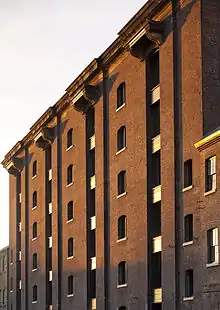Elephant and Castle
The Elephant and Castle is an area around a major road junction in south London, England, in the London Borough of Southwark. Although the name also informally refers to the areas of Walworth and Newington, the proximity of the London Underground station of the same name has led to the area being more commonly known as "Elephant and Castle". The name is derived from a local coaching inn.
| Elephant and Castle | |
|---|---|
 Statue at the Elephant & Castle tube station | |
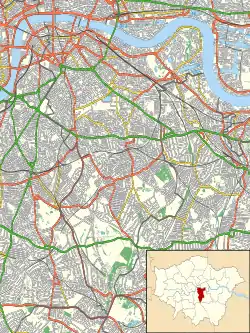 Elephant and Castle 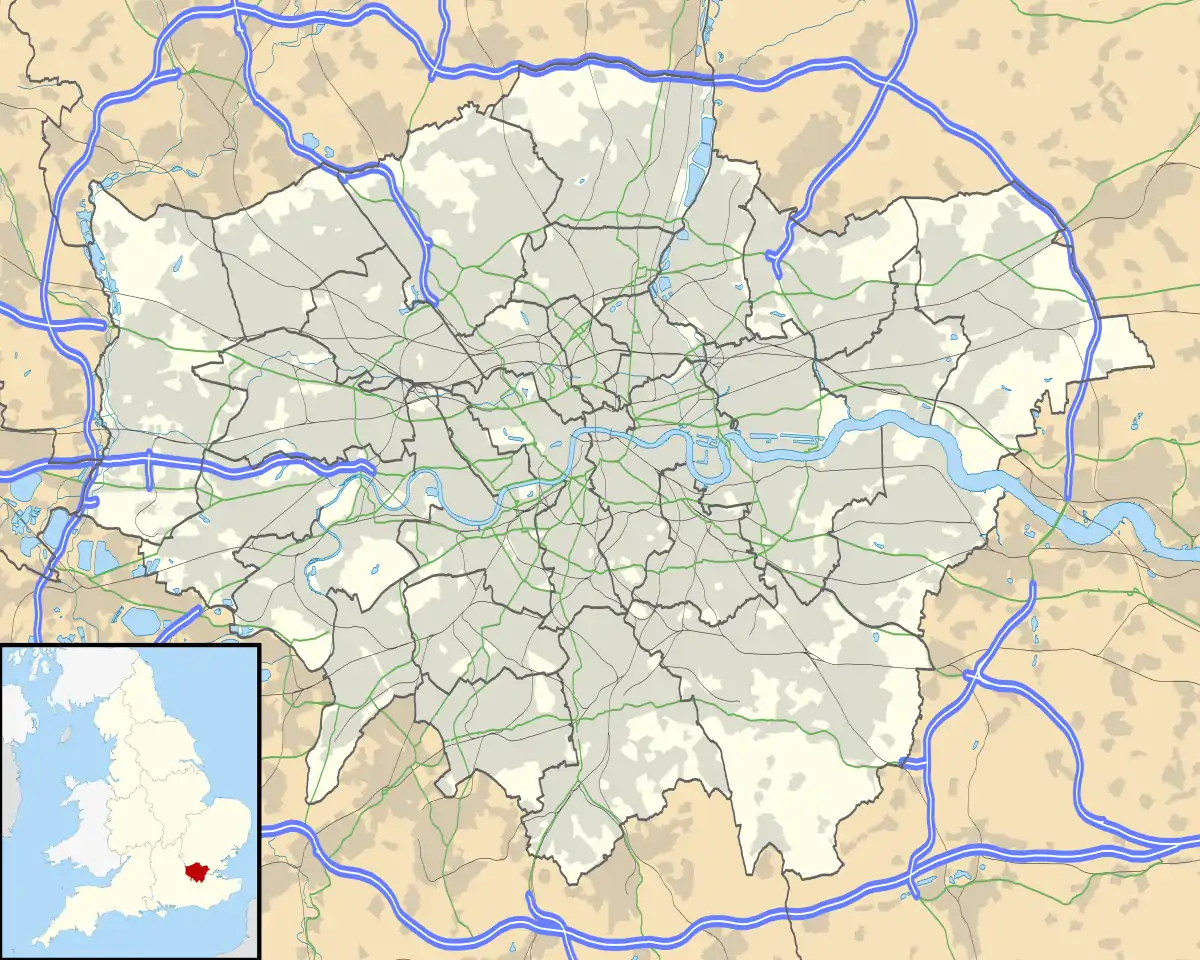 Elephant and Castle Location within Greater London | |
| OS grid reference | TQ319789 |
| London borough | |
| Ceremonial county | Greater London |
| Region | |
| Country | England |
| Sovereign state | United Kingdom |
| Post town | LONDON |
| Postcode district | SE1, SE11, SE17 |
| Dialling code | 020 |
| Police | Metropolitan |
| Fire | London |
| Ambulance | London |
| London Assembly | |
"The Elephant", as locally abbreviated, consists of major traffic junctions connected by a short road called Elephant and Castle, part of the A3. Between these junctions, on the eastern side, is the (now closed for regeneration) Elephant and Castle Shopping Centre, with the Hannibal House office block above. To the north of this, bounded by Newington Causeway and New Kent Road is the Metro Central Heights. The Strata residential block lies just south of the shopping centre on Walworth Road.
Traffic runs to and from the south-east of England along the A2 (New Kent Road and Old Kent Road), the south of England on the A3, to the West End via St George's Road, and to the City of London via London Road and Newington Causeway at the northern junction. Newington Butts and Walworth Road adjoin the southern junction. The whole junction forms part of the London Inner Ring Road and part of the boundary of the London congestion charge zone.
The Elephant has two linked London Underground stations, on the Northern and Bakerloo lines, and a National Rail station served by Southeastern (Kentish Town to Sevenoaks via Catford) and Thameslink (suburban loop to Sutton and Wimbledon), and other Thameslink services to Kent.
Local buildings include Skipton House, part of the Department of Health; Perronet House, an award-winning residential block owned by Southwark Council; a large part of the London South Bank University campus; the London College of Communication; the Ministry of Sound nightclub; and the Metropolitan Tabernacle. The Cuming Museum is nearby on Walworth Road.
Name
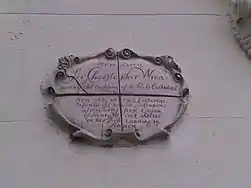
.jpg.webp)
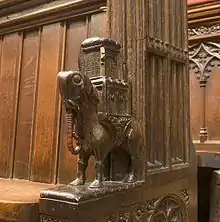
The name "Elephant and Castle" is derived from a coaching inn.[1] The earliest surviving record of this name in relation to this area appears in the Court Leet Book of the Manor of Walworth, which met at "Elephant and Castle, Newington" on 21 March 1765.[2] The inn's name is sometimes explained as an English corruption of "La Infanta de Castilla", a reference to a Spanish princess with an English connection, such as Eleanor of Castile or Katherine of Aragon (who before her marriage was la ynfante doña Catalina de Castille y Aragon, "infanta of Castile and Aragon"), or perhaps the 17th century Maria Anna of Spain, unsuccessfully pursued as a bride by Charles I. This is considered an improbable etymology. [3][4] Previously the site was occupied by a blacksmith and cutler – the crest of the Worshipful Company of Cutlers features an elephant with a castle (representing a howdah) on its back, which in turn was used because of the use of elephant ivory in handles; this association with the Worshipful Company of Cutlers is considered a far more likely explanation for the name.[2]
Shakespeare mentions the Elephant Lodgings in Twelfth Night. In Act 3 Scene 3 Antonio says "In the south suburbs, at the Elephant, is best to lodge."[5] Although the play is set in Illyria in the Balkans, Shakespeare often used local London references. The theatres were all in Southwark, so Shakespeare's line may represent an advertisement for a local hostelry. "The Elephant" is a common present-day nickname for the Elephant and Castle.[6]
'Newington' is one of the most common place names in England (see Newington Green and Stoke Newington in north London), and from 1750 the area became more important and the informal name, from the pub at this junction, was adopted. Compare 'Angel' at Islington, or Bricklayers Arms, a short distance along New Kent Road.
The inn site was rebuilt in 1816 and again in 1898, and the present Elephant & Castle pub, at the junction of New Kent Road and Newington Causeway, was part of the 1960s comprehensive redevelopment.
History
Medieval and early modern
Known previously as Newington (Newington Butts and Newington Causeway are two of the principal roads of the area), in the medieval period it was part of rural Surrey, in the manor of Walworth. This is listed in the Domesday Book as belonging to the Archbishop of Canterbury; the income from its rents and tithes supplied the monks at Christ Church Canterbury with their clothing, and a 'church' is mentioned.[7] The parish was called St Mary, Newington, which church occupied the southwest side of today's southern roundabout, near the Tabernacle, and was first recorded by name in 1222.[7]
In May 1557, William Morant, Stephen Gratwick and a man named King, known as the Southwark Martyrs, were burnt at the stake in St George's Field on the site of the present Tabernacle during the Marian Persecutions.[8]
St Mary's Church was rebuilt in 1720 and completely replaced in 1790, to a design of Francis Hurlbatt. Within another hundred years this too was to be demolished, with its replacement on Kennington Park Road ready in 1876.[9] It was destroyed by bombing in 1940 during the Second World War.[9] The remains of the tower and an arch were incorporated into its replacement of 1958. The open space is still known as St Mary's Churchyard, and the narrow pedestrian walk at its south end is Churchyard Row.
There is record of a 'hospital' before the Reformation. In 1601 the Worshipful Company of Fishmongers erected St Peter's Hospital on the site of the present London College of Communication. This expanded and survived until 1850, when it was removed to Wandsworth. The Drapers' livery company created Walters' Almshouses on a site now at the southern junction island in 1640, giving the tower block opposite the name Draper House. The almshouses were relocated to Brandon Street in the 1960s as part of the major redevelopment.
Rise to metropolitan prominence (1750–1900)
.png.webp)
_p051_-_Elephant_and_Castle_(map).jpg.webp)
The area became increasingly important after the building of Westminster Bridge in 1751 and the improvements to London Bridge in the same period. These required 'by-pass' roads across the south side approaches to each other and also to the main routes to the south and southeast coasts. These road improvements – Great Dover Street, Westminster Bridge, New Kent Road, St George's Road and Borough Road – connect to the older Kennington and Old Kent Roads to facilitate this traffic. In 1769 the new Blackfriars Bridge was connected to this system at what is now St George's Circus and Blackfriars Road (originally Great Surrey Road) and to the Elephant junction with the new London Road. As a result of these improvements, the area became a built-up part of the metropolis during the late Georgian and Victorian periods.[10][11]
The railway arrived here in 1863 and the first deep-level tube line, now part of the Northern line's City Branch, in 1890. The Bakerloo line terminus was created in 1906.[12] Both the middle-class and working-class populations increased, the first settling on the major roads, the latter on the streets behind these. However, the area declined socially at the Walworth side.
In the 19th century the nationally famed Baptist preacher Charles Haddon Spurgeon built the Metropolitan Tabernacle here.[13] The building, designed by William Willmer Pocock,[13] was finished in 1861 and dedicated on 18 March. It was bombed in the blitz but the portico and basement survived and in 1957 the Tabernacle was rebuilt to a new but much smaller design accommodating surviving original features.
During the late 19th century there was a cemetery in the vicinity,[14] but it was built over during London's rapid expansion. A few gravestones remain in St. Mary's Churchyard.
Peak years: 1900–1939
The area became the location for a thriving shopping area, known as "the Piccadilly (Circus) of South London",[15] with its own department store (William Tarn and Co) and many smaller outlets. Also featured were a shoe factory, a branch of Burton and a renowned hatter.
In 1930, the Trocadero, a monumental neo-Renaissance style picture house seating over 3000 and fitted with the largest Wurlitzer organ imported to the United Kingdom, was built at the northern corner of the New Kent Road (a plaque commemorating the building was unveiled in 2008 by Denis Norden, who had worked there in his youth).[16] This was replaced in 1966 by a smaller cinema (the Odeon, known for a time after closure as an Odeon in 1982 as the Coronet, not to be confused with the Coronet below) which was demolished in 1988.
In 1932, another cinema opened across the street, The Coronet. It is now mostly used as a night-club and concert venue.[17] At the time it seated over 2000 people, and was an art-deco conversion of the Elephant and Castle theatre, opened in 1879 on the site of the short-lived Theatre Royal (built in 1872 and burnt down six years later). It was reconstructed in 1882 and again in 1902.
One monument to cinema still remains just off the Elephant, the Cinema Museum is a volunteer-run museum with screenings of classic cinema and a vast collection of cinema memorabilia. It is located in the old workhouse where Charlie Chaplin spent time as a child.
Second World War
The Elephant was the centre of the target zone for the German air raids on London on 10 May 1941 and suffered "raging fires".[18][19]
Post-war rebuilding (1945–2000)
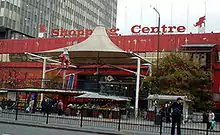
The major development of the 1960s consisted of post-war reconstruction to a larger metropolitan plan, much of it replacing properties destroyed by bombing in World War II. Alexander Fleming House (1959), originally a group of government office blocks and now Metro Central Heights residential complex, is a prime example of the work of the Hungarian modernist architect Ernő Goldfinger.
The shopping centre, designed by Boissevain & Osmond for the Willets Group, was opened in March 1965. It was the first covered shopping mall in Europe,[20] with 120 shops on three levels and a two-storey underground car-park. In the sales brochure (1963), Willets claimed it to be the "largest and most ambitious shopping venture ever to be embarked upon in London. In design planning and vision it represents an entirely new approach to retailing, setting standards for the sixties that will revolutionise shopping concepts throughout Britain." When it opened, budget restrictions meant that the proportions and finishes of the building had had to be scaled down and only 29 out of a possible 120 shops were trading.
The Elephant is the location of the London College of Communication, formerly the London College of Printing, an internationally renowned dedicated college, part of University of the Arts London. The present structure was constructed during the redevelopment of the area in the early 1960s.
In 1974 the Brutalist Heygate Estate, designed by Tim Tinker,[21] was completed.[22] It was home to more than 3,000 people.[23] The estate was once a popular place to live, the flats being thought light and spacious,[24] but the estate later developed a reputation for crime, poverty and dilapidation.[25]
Transport
The Elephant was to have been served by the Cross-River Tram,[26] which was cancelled in 2008 due to budgetary constraints.[27]
In 2010, the southern roundabout was converted to traffic light operation, with the creation of new cycle lanes and pedestrian crossings.[28] This included the removal of the pedestrian subways, described as "unpopular and imtimidating" by a local councillor.[29]
However, in 2014 the Elephant & Castle junction was still "Britain’s highest cycle casualty roundabout",[30] prompting a TfL proposal to remove the northern roundabout as part of a £4bn package of road improvements targeting cyclists' safety.[31] TfL implemented its proposal in 2015, connecting the roundabout island to the shopping centre, thereby creating a new public space called Elephant Square.
Housing, redevelopment and gentrification
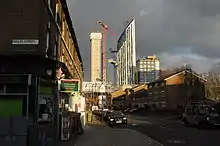
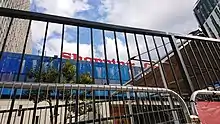
In recent times the area has had a reputation for successful ethnic diversity and centrality. The area's proximity to major areas of employment, including Westminster, the West End and the City, has meant that a certain amount of gentrification has taken place[32]
The area is now subject to a master-planned redevelopment budgeted at £1.5 billion. A Development Framework was approved by Southwark Council in 2004. It covers 170 acres (688,000 m²) and envisages restoring the Elephant to the role of major urban hub for inner South London that it occupied before World War II.[33]
A substantial amount of post-World War II social housing that is deemed to have failed will be demolished, including the Heygate Estate, replaced with developments consisting of a mix of social and private-sector housing. This portion of the site is being developed by Lend Lease. There have also been moves to protect the last of the architecturally important tenement blocks nearby through the creation of a conservation area covering the Pullens buildings.
As of 2014, numerous tall residential buildings have been approved or are under construction, in addition to the 148m Strata SE1 tower completed in 2010. These include One The Elephant (124m),[34] the built-for-rent Highpoint (previously called 360 London) (134m)[35][36] and "Two Fifty One" (on the site of Eileen House) (134m)[37] and "Elephant Central" (a complex of three high-rise buildings on a "podium", formerly known as Oakmayne Plaza and later Tribeca Square and Elephant 1).[38][39] Southwark Council also built a new leisure centre which opened in 2016, to replace the previous Castle centre, which closed in 2012.[40][41]
In 2015, after several u-turns from the previous owner, the new owners of the shopping centre, Delancey, announced that the building would be demolished and published redevelopment plans to be completed by the early 2020s. The scheme includes a new home for the nearby London College of Communication on the current site of the Coronet Theatre, a cinema (originally planned for the "Elephant Central" development), retail units and housing.[42]
London's growing Latin American population, which has largely resided at the Elephant since the 1980s, are also taking part in the regeneration project. Plans are being made to build new shops and homes to transform it into a "Latin American corridor".[43][44]
In December 2018, it was announced that London Mayor Sadiq Khan had approved redevelopment plans, and that Southwark Council had too, after changes to proposals to ensure more windows in the shopping centre, 350 out of 1000 homes for rent at "genuinely affordable levels" and for traders in the current centre with rents capped for 15 years.[45]
In January 2020, a closure date was set for the centre of 30 July 2020.[46] The closure date was postponed to 24 September 2020 due to the COVID-19 pandemic.[47][48] The centre will be redeveloped despite public opposition.
Notable residents
In the middle of the former northern roundabout, now Elephant Square, is the Michael Faraday Memorial, a large stainless steel box built in honour of Michael Faraday, who was born nearby. It contains an electrical substation for the Northern line of the London Underground.
Famous former residents include Charlie Chaplin[49] and Michael Caine, who were born and grew up locally.[50]
Gay rights activist Peter Tatchell lives on the Rockingham Estate, where the Council installed a blue plaque in his name in 2010.[51]
The rock band The Maccabees has its studio nearby, while its 4th album, Marks to Prove It, released on 31 July 2015, pays tribute to the area.[52]
Arsenal footballer Reiss Nelson was born in Elephant and Castle.
Transport
London Underground
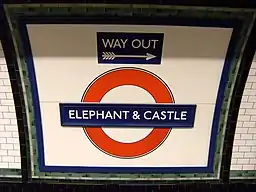
Elephant & Castle tube station serves the area.
The station is served by Northern line trains on the Bank branch, linking the area directly to the City, and destinations such as London Bridge, King's Cross St Pancras, and Camden Town to the north. Southbound trains travel towards Morden via key destinations such as Kennington, Clapham, and South Wimbledon.
The station is the southern terminus of the Bakerloo line, which runs northbound to Harrow and Wealdstone. The line links the area to Waterloo, the West End, Paddington, Willesden, and Wembley Central along the way.[53]
The station is on the boundary between London fare zones 1 and 2.
Transport for London (TfL) is proposing to extend the Bakerloo line southwards from Elephant & Castle to Lewisham. The line would run beneath Old Kent Road.[54]
National Rail
Elephant & Castle railway station is served by Southeastern and Thameslink trains, which serve destinations across London, the South East, and East Anglia. Key destinations include Ashford International, Bedford, Dover Priory, London Blackfriars (in the City), Luton and Luton Airport (![]() ), St Albans City, St Pancras International, Sutton, and Wimbledon.[53]
), St Albans City, St Pancras International, Sutton, and Wimbledon.[53]
The station is on the boundary between London fare zones 1 and 2.
Buses
Elephant & Castle is served by London Buses routes 1, 12, 35, 40, 45, 53, 63, 68, 133, 136, 148, 155, 168, 171, 172, 176, 188, 196, 333, 343, 344, 360, 363, 388, 415, 453, 468, C10, P5, N1, N35, N63, N68, N89, N133, N155, N171 and N343.[55][56]
Cycling
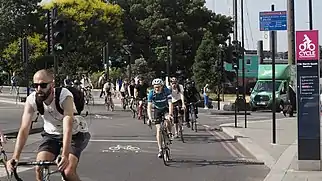
TfL and the London Borough of Southwark maintain cycling infrastructure in the area.
Elephant and Castle is the southern terminus of Cycleway 6, which runs northwards to Blackfriars, Farringdon, Bloomsbury, and King's Cross. The cycleway runs unbroken and signposted along the entirety of its route. The section between Elephant and Castle and Farringdon runs along traffic-free bike freeway. The northern terminus of C6 is in Kentish Town.
Cycle Superhighway 7 passes north-south through Elephant and Castle. The route is signposted and carries cyclists from Elephant and Castle northbound to the City, via Southwark Bridge. Southbound, the route runs without interruption to Collier's Wood, via Kennington, Clapham, and Tooting.[57]
A shared-use path for pedestrians and cyclists runs alongside New Kent Road east from Elephant and Castle, which links the area to the nearby Bricklayer's Arms.
The Santander Cycles bicycle-sharing system operates in Elephant and Castle.[57]
Road
Elephant and Castle is a busy road junction. The London Inner Ring Road passes through the junction. The A3 also passes through the junction, which carries traffic between the City and destinations such as Kennington, Clapham, Gatwick Airport (![]() ), and Portsmouth.
), and Portsmouth.
Air pollution from road traffic in Elephant and Castle has significantly improved in recent years. In 2015, Elephant and Castle exceeded the UK government legal limit on Nitrogen Dioxide, with the local borough recording an annual mean concentration of 41 micrograms per cubic metre (μg/m^3). In 2017, this figure was 34μg/m^3, below the legal limit, and in 2018, the figure was 32μg/m^3. The limit set by the Department for Environment, Food, and Rural Affairs is 40μg/m^3.[58]
See also
- Elephant and Castle Pub and Restaurant, a restaurant chain in North America named after this area in London
References
-
Compare Simpson, Jacqueline (2011). "Elephant and Castle". Green Men & White Swans: The Folklore of British Pub Names. Random House. pp. 90–92. ISBN 9780099520177. Retrieved 11 February 2015.
The most famous pub of this name has long been demolished, but the area of London where it once stood is still known as the Elephant. [...] In the Middle Ages the elephant was regularly linked with the 'castle' both in the written descriptions in Bestiaries and in visual art, e.g. in church carvings.
- Albert Jack (3 September 2009). The Old Dog and Duck: The Secret Meanings of Pub Names. Penguin Books Limited. pp. 95–97. ISBN 978-0-14-192991-0.
- https://www.researchgate.net/publication/305216410_Raising_infanta_Catalina_de_Aragon_to_be_Catherine_queen_of_England
- Toksvig, Sandi, Between the Stops: The View of My Life from the Top of the Number 12 Bus
- William Shakespeare. "Twelfth Night". MIT. Retrieved 29 March 2014.
- "A History of the Elephant & Castle (Part One)". Retrieved 10 June 2014.
- Darlington, Ida (1955). "The manor of Walworth and parish of St. Mary, Newington". Survey of London: volume 25: St George's Fields (The parishes of St. George the Martyr Southwark and St. Mary Newington). British History Online. pp. 81–90. Retrieved 16 September 2014.
- Amos Blanchard (1844). Book of Martyrs: Or, A History of the Lives, Sufferings and Triumphant Deaths of the Primitive and Protestant Martyrs, from the Introduction of Christianity, to the Latest Periods of Pagan, Popish, Protestant, and Infidel Persecutions... N. G. Ellis. p. 272.
- Darlington, Ida (1955). "Survey of London: volume 25: St George's Fields (The parishes of St. George the Martyr Southwark and St. Mary Newington)". The Church of St Mary, Newington. British History Online. pp. 91–94. Retrieved 16 September 2014.
- "Southwark". ideal-homes.org.uk – A History of South-east London suburbs. Retrieved 2 May 2014.
- Ida Darlington (ed.). "St George's Fields – Enclosure and development". British History Online. Retrieved 2 May 2014.
- Matters, Transport for London | Every Journey. "London Underground". www.tfl.gov.uk.
- John Richardson (2000). The Annals of London: A Year-by-year Record of a Thousand Years of History. University of California Press. p. 285. ISBN 978-0-520-22795-8.
- "500 skeletons found at Elephant and Castle building site". BBC News. 4 October 2012.
- "Heygate Estate residents fight compulsory purchase order". BBC News. 29 August 2012. Retrieved 29 March 2014.
- "History". The Trocadero Wurlitzer Trust. Archived from the original on 13 May 2014. Retrieved 16 September 2014.
- "Coronet – The Coronet Theatre London". coronettheatre.co.uk.
- Mortimer, Gavin. The Bombing of London on 10 May 1941. The Berkeley Publishing Group, 2005. p. 18, 251.
- "Blitz WW2 – The Battle of London". Military History Monthly. 22 January 2011. Retrieved 2 May 2014.
- "Reinventing the high street: Elephant and Castle's transformation". The Daily Telegraph. London. 14 October 2013. Retrieved 29 March 2014.
- Moss, Stephen (4 March 2011). "The death of a housing ideal". The Guardian. London.
- Collins, Michael (23 December 2001). "The Elephant's grave yard". The Guardian. London. Retrieved 4 May 2010.
- "Design for Social Sustainability : A Framework for Creating Thriving New Communities" (PDF). Plannig.ri.gov. Archived from the original (PDF) on 4 March 2014. Retrieved 28 February 2014.
- Walker, Peter (3 September 2010). "South London's Heygate estate mourned by locals – and Hollywood". 'The Guardian'.
- "Heygate estate". BBC London. Retrieved 2 October 2013.
- "Cross River Tram" (PDF). London Assembly. October 2008. Archived from the original (PDF) on 4 October 2015. Retrieved 29 March 2014.
- "TfL scraps projects and cuts jobs". BBC News. 6 November 2008. Retrieved 29 March 2014.
- "Elephant & Castle southern roundabout to be removed by 11 October". London SE1. 28 September 2010. Retrieved 29 March 2014.
- "Elephant and Castle's 'intimidating' subways closed". BBC News. 17 January 2011. Retrieved 2 May 2014.
- Matthew Beard (26 February 2014). "£290m plan to make London roundabouts safer and less threatening to cyclists". London Evening Standard. Retrieved 29 March 2014.
- "£4bn plan to revamp London's roads announced". BBC News. 4 March 2004. Retrieved 29 March 2014.
- "Mapping gentrification". The Economist.
- "Elephant & Castle regeneration". Retrieved 23 January 2016.
- "One The Elephant: Lend Lease aims to cash in on Hyde Park effect". London SE1.
- "Boris: work starts next year on 44-storey Elephant & Castle tower". London SE1.
- Youde, Kate (19 May 2016). "Why build-to-rent could be a boon for architects".
- "Eileen House: Boris Johnson approves Newington Causeway tower". London SE1.
- "Living in Elephant and Castle:area guide to homes, schools and transport links". Homes & Property.
- "Tribeca Square: work starts on New Kent Road homes, cinema & supermarket". London SE1.
- "The Castle leisure centre". southwark.gov.uk.
- "Castle leisure centre to open on Saturday 30 April". southwark.gov.uk.
- "New Elephant & Castle Shopping Centre redevelopment plans on show". London SE1.
- "Lib Dems promise 'Latin American corridor' from Elephant to Stockwell". London-se1.co.uk. 21 April 2009. Retrieved 6 December 2012.
- "Latin Americans must take full part in Elephant & Castle regeneration says London Assembly chair". London-se1.co.uk. 21 April 2009. Retrieved 6 December 2012.
- E Hopkirk, 'Mayor approves huge Elephant & Castle redevelopment' (11 December 2018) Building.co.uk
- "Elephant & Castle Shopping Centre to close after 55 years". London-se1.co.uk. 17 January 2020.
- "Elephant & Castle Shopping Centre: closure date postponed". London-se1.co.uk. 12 May 2020.
- "'We're going to miss the community': Elephant and Castle shopping centre closes after 55 years". the Guardian. 24 September 2020. Retrieved 28 September 2020.
- "Charlie Chaplin". The Workhouse. Retrieved 2 May 2014.
- "Michael Caine interview – for his autobiography The Elephant to Hollywood". The Daily Telegraph. London. 4 October 2010. Retrieved 2 May 2014.
- "Human rights protester Peter Tatchell gets blue plaque". BBC News. London. 29 September 2010. Retrieved 19 October 2015.
- "The Maccabees: Why we love Elephant and Castle". BBC News. 4 August 2015. Retrieved 19 October 2015.
- "London's Rail and Tube services" (PDF). Transport for London and National Rail.
- "Bakerloo line extension". Transport for London. Archived from the original on 3 January 2020. Retrieved 22 April 2020.
- "Buses from Elephant & Castle" (PDF). Transport for London. Archived (PDF) from the original on 23 February 2020. Retrieved 22 April 2020.
- "Night Buses from Elephant & Castle" (PDF). Transport for London. Archived (PDF) from the original on 22 April 2020. Retrieved 22 April 2020.
- "Cycle". Transport for London.
- "Southwark Air Quality Annual Status Report 2018" (PDF). London Borough of Southwark. June 2019. Archived (PDF) from the original on 22 April 2020. Retrieved 22 April 2020.
External links
| Wikimedia Commons has media related to Elephant and Castle. |
- Elephant and Castle regeneration masterplan
- Elephant and Castle Roundabout "Making a Space a Place"

